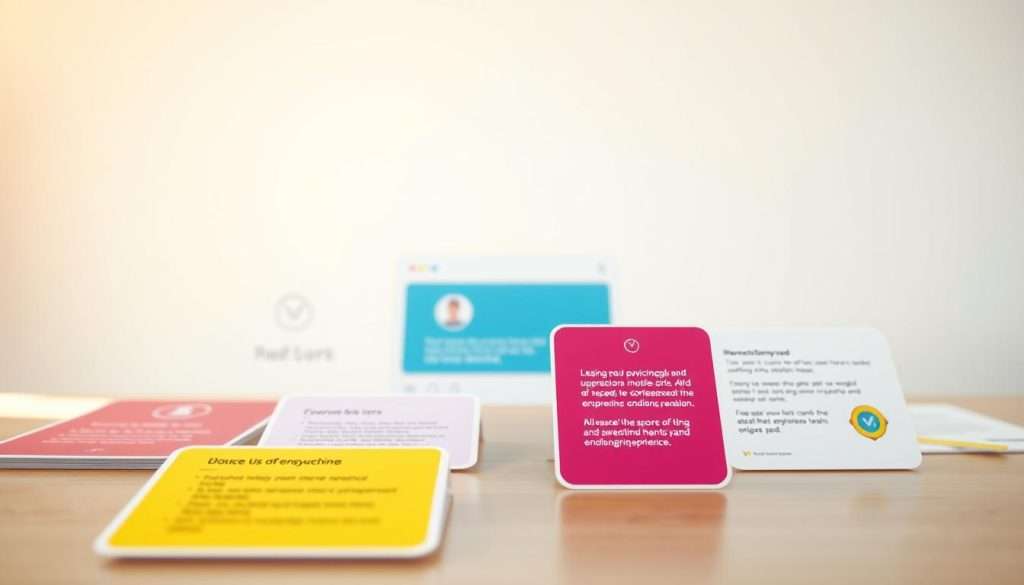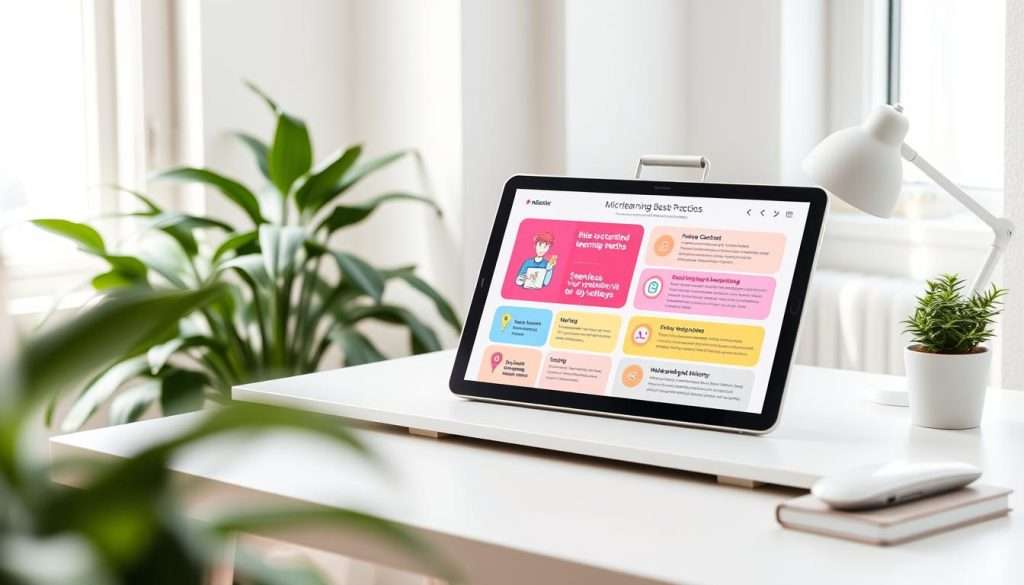Learning new things can be tough. With so much info out there, it’s hard to know where to start. That’s where microlearning comes in. It’s a method that breaks learning into small, easy-to-digest pieces.
Microlearning gives you content in short, focused chunks, usually 3 to 7 minutes. It zeroes in on what you need to learn and works best on digital devices, especially mobile ones. It makes studying fun and effective.
We think learning should be fun and engaging. Microlearning makes it possible. By adding it to your study routine, you’ll get more done and stay excited about learning.
Key Takeaways
- Microlearning is an effective way to learn new skills and boost productivity.
- It involves delivering content in short, structured bursts.
- This technique is most effective when delivered digitally, especially in mobile-first formats.
- Microlearning can help transform studying into an enjoyable experience.
- It’s perfect for those looking for a practical and engaging way to learn.
The Art of Microlearning: What It Is and Why It Matters
Microlearning is about making learning short and focused. It meets the needs of today’s learners who face a lot of information. This makes it hard to learn and remember new things.
To get what microlearning is about, we need to look at its main ideas.
Defining the Core Principles of Microlearning
Microlearning has key principles that help learners stay engaged and remember what they learn. It’s concise, focusing on one thing at a time. This makes it easier to understand. It’s flexible, letting learners access content whenever they want. It uses engaging multimedia elements to keep learners interested.
How Microlearning Differs from Traditional Learning Methods
Unlike old learning methods, microlearning gives information in small pieces. This reduces cognitive overload and helps learners quickly learn and use new skills. By using microlearning strategies, companies can better train employees and improve how well they remember things. This leads to the benefits of microlearning.
In short, microlearning is a modern, effective way to learn. It’s engaging and efficient. By knowing its core principles and how it’s different from old methods, we can use it to better learning outcomes.
The Science Behind Microlearning’s Effectiveness
Microlearning’s success comes from its roots in cognitive science and psychology. It uses these principles to improve how we remember and learn. This makes learning more effective.
Cognitive Load Theory and Information Processing
Cognitive Load Theory (CLT) explains how microlearning works. It says our brains can only handle so much at once. Too much info can overwhelm us. Microlearning fixes this by breaking down big ideas into smaller pieces. This makes learning easier and more efficient.
| Key Principle | Description | Benefit |
|---|---|---|
| Cognitive Load Management | Breaking down information into smaller chunks | Reduces cognitive overload |
| Focused Learning Objectives | Clearly defined learning goals | Enhances knowledge retention |
The Psychology of Spaced Repetition and Knowledge Retention
Spaced repetition is a big part of microlearning. It means reviewing material at longer and longer intervals. This helps keep the information in our long-term memory. Microlearning makes it easier to remember and recall what we’ve learned.
Key Benefits of Implementing Microlearning Strategies
Microlearning is great because it offers focused, short learning sessions. These sessions meet the needs of today’s learners. They make learning more personal and efficient.
Enhanced Knowledge Retention and Recall
Microlearning helps learners keep information better. It breaks down content into small pieces. This makes it easier for learners to absorb and retain information more effectively.
This method also helps learners remember what they’ve learned. It reduces the feeling of being overwhelmed. This way, learners can recall information more accurately.
Increased Learner Engagement and Motivation
Microlearning makes learning fun and interactive. It motivates learners to keep going. This leads to more learners finishing their courses and achieving better results.
Flexibility and Accessibility for Modern Learners
Microlearning is flexible and accessible. Learners can access content anytime, anywhere. This is especially helpful for those with busy schedules, like employees.
| Benefit | Description | Impact on Learners |
|---|---|---|
| Enhanced Retention | Bite-sized learning content | Better knowledge retention |
| Increased Engagement | Interactive learning elements | Higher motivation and completion rates |
| Flexibility and Accessibility | Learning anytime, anywhere | Accommodates busy schedules |
How Organizations Benefit from Microlearning Approaches
Adopting microlearning strategies brings big wins for companies. It’s more than a trend; it’s a major shift for better training.
Cost-Effectiveness and Return on Investment
Microlearning is super cost-effective. Old-school training costs a lot in setup, materials, and staff. But, microlearning platforms offer top-notch training for less. They use digital content that’s easy to update and share online.
This saves on space and keeps workers on the job. It’s a big win for the wallet and productivity.
| Training Method | Cost | Time Efficiency |
|---|---|---|
| Traditional Training | High | Low |
| Microlearning | Low | High |
Rapid Development and Deployment Advantages
Microlearning is quick to make and use. With microlearning in education and corporate training, you can get content out fast. This speed is key in today’s fast world.
It lets you keep up with changing needs. This is a big plus for staying ahead.
Using microlearning cuts costs and boosts training results. It’s a smart choice for companies wanting to quickly improve their team’s skills.
Essential Elements of Effective Microlearning Content
Good microlearning content has focused learning goals, engaging multimedia, and interactive tests. To make great microlearning, you must know how to put these key parts together.
Crafting Focused Learning Objectives
Focused learning goals are the base of good microlearning. They keep you on track and make sure learners reach their goals.
Single-Concept Focus Techniques
Sticking to one idea per module stops information overload. This way, learners can understand and remember better.
Action-Oriented Learning Goals
Action-oriented goals push learners to use what they’ve learned. This method improves retention and boosts confidence.
Incorporating Engaging Multimedia Elements
Using videos, images, and animations makes learning fun. These multimedia elements make your content more engaging and interactive.
Designing Interactive Assessment Methods
Interactive tests are key to solidifying learning and keeping knowledge. Quizzes and gamification keep learners interested and motivated.
By mixing these methods, you can make microlearning that’s both fun and effective.
Step-by-Step Guide to Creating Powerful Microlearning Modules
Creating effective microlearning modules is easy when you break it down. First, understand what makes microlearning work. We’ll show you how to make content that’s both engaging and informative.
Identifying Topics Suitable for Microlearning Format
Start by picking topics that need specific skills or knowledge. Think about software training, compliance, or soft skills. Choose topics that are short and can fit into a brief module. For example, “Effective Communication” can be split into “Active Listening” and “Clear Messaging.”

Breaking Down Complex Concepts into Digestible Units
To make complex info easier, break it down into smaller chunks. Analyze the content, find key points, and arrange them logically. This makes the content easy to follow. For instance, “Data Analysis” can be split into “Data Collection,” “Data Cleaning,” and “Data Interpretation.”
- Identify the core concept
- Break it down into smaller topics
- Organize the content into a logical sequence
Incorporating Engagement Mechanisms and Gamification
Gamification and engagement are key to keeping learners interested. Use quizzes, challenges, and rewards to make learning fun. For example, learners can earn points or compete on a leaderboard.
“Gamification is not just about making learning fun; it’s about creating an engaging experience that motivates learners to achieve their goals.”
Testing, Gathering Feedback, and Refining Your Modules
After making your modules, test them with your audience. Get feedback on content, structure, and effectiveness. Use this feedback to improve your modules. This process ensures your content is top-notch.
- Test your modules with a small group
- Gather feedback and analyze the results
- Refine your modules based on the feedback
By following these steps, you can make engaging microlearning modules. Remember, the key is to keep it short, focused, and interactive.
Implementing Microlearning in Different Learning Environments
Microlearning is versatile and can be used in many places. It’s great for both employee training and schools. It makes learning better and more fun.
Microlearning for Employee Training and Development
Microlearning is great for training at work. It gives short, focused lessons that fit into busy schedules. This way, employees can learn new things without feeling stressed.
Onboarding Applications
New employees can learn important company stuff through microlearning. It teaches them about policies, skills, and culture in easy steps.
Skill Development Programs
Microlearning helps employees keep learning new skills. They can learn at their own speed and focus on what they need for their job.
Microlearning in Educational Settings
In schools, microlearning adds to regular teaching. It gives students extra help and makes sure they remember important ideas.
It’s especially helpful in college. Students can handle big topics in smaller pieces. This helps them keep up with their studies.
Self-Directed Microlearning Strategies
Microlearning lets learners take charge of their learning. They can pick from a wide range of modules to improve where they need to.
To make self-directed learning work best, a strong microlearning platform is key. It should make it easy for learners to find and use the right content.
Overcoming Common Microlearning Challenges
Microlearning has many benefits but also faces unique challenges. These challenges need careful strategies to solve. As you start using microlearning, you might find issues that affect its success. Let’s look at some common problems and how to solve them.
Addressing Content Depth vs. Brevity Concerns
One big challenge in microlearning is finding the right balance between depth and brevity. To tackle this, focus on one learning goal per module. Make sure the content is short but still covers everything needed to meet the goal.
Using multimedia elements like videos and quizzes can make complex info easier to understand. This helps keep learners interested.

Ensuring Coherence Across Multiple Microlearning Units
To keep things consistent across different microlearning units, create a clear learning path. Show how each module fits into the bigger picture.
Keep branding and design the same in all modules. This makes the learning experience smooth and easy to follow.
Top Microlearning Platforms and Tools for 2023
In 2023, the world of microlearning is growing fast. We have many platforms and tools to choose from. This shows how much people want learning options that fit their needs and likes.
Mobile Learning Applications and Their Features
Mobile apps have changed how we learn. They give us on-the-go access to educational content. Here are some top apps:
- Duolingo: A language app that makes learning fun with games.
- Coursera: A big online course platform with courses from top schools.
- Udemy: Offers courses on many subjects, from business to creative skills.
These apps have cool features like personalized learning paths, interactive quizzes, and discussion forums. They make learning fun and effective.
Video-Based Microlearning Solutions
Video-based learning is getting popular. It’s great for sharing complex info in a short and fun way. Here are some top platforms:
- YouTube: A huge video site with lots of educational videos.
- Vimeo: A video hosting site with educational videos, including microlearning.
- Kaltura: A video platform with hosting, streaming, and analytics.
These platforms have cool features like video analytics, closed captions, and subtitles. They help track how well learners understand the content.
Interactive Microlearning Software and Authoring Tools
Interactive tools help make learning fun and engaging. Here are some top tools:
- Articulate Storyline: An e-learning tool for creating interactive content like quizzes.
- Adobe Captivate: Offers features like branching scenarios and interactive quizzes.
- Lectora Inspire: Allows creating interactive content and games.
These tools have great features like drag-and-drop functionality, branching scenarios, and gamification. They help make learning fun and interactive.
Conclusion: Embracing the Future of Learning Through Microlearning
Microlearning is changing how we learn, making it more effective and fun. It boosts our productivity and keeps us engaged. This leads to better memory and understanding of new skills.
Microlearning breaks down hard topics into easy-to-digest pieces. It’s great for students, professionals, and anyone who loves to learn. It offers flexibility and is easy to access in our busy lives.
Looking ahead, microlearning could change learning forever. It promises a more efficient, enjoyable, and effective way to learn. This benefits everyone, making learning a positive experience for all.

